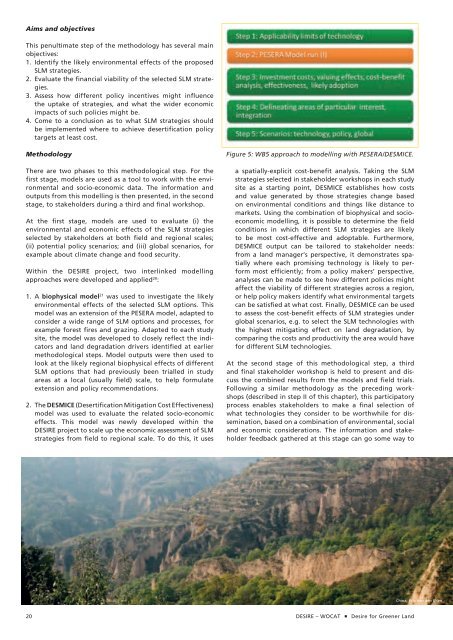Desire for Greener Land
Desire for Greener Land
Desire for Greener Land
You also want an ePaper? Increase the reach of your titles
YUMPU automatically turns print PDFs into web optimized ePapers that Google loves.
Aims and objectives<br />
This penultimate step of the methodology has several main<br />
objectives:<br />
1. Identify the likely environmental effects of the proposed<br />
SLM strategies.<br />
2. Evaluate the financial viability of the selected SLM strategies.<br />
3. Assess how different policy incentives might influence<br />
the uptake of strategies, and what the wider economic<br />
impacts of such policies might be.<br />
4. Come to a conclusion as to what SLM strategies should<br />
be implemented where to achieve desertification policy<br />
targets at least cost.<br />
Methodology<br />
There are two phases to this methodological step. For the<br />
first stage, models are used as a tool to work with the environmental<br />
and socio-economic data. The in<strong>for</strong>mation and<br />
outputs from this modelling is then presented, in the second<br />
stage, to stakeholders during a third and final workshop.<br />
At the first stage, models are used to evaluate (i) the<br />
environmental and economic effects of the SLM strategies<br />
selected by stakeholders at both field and regional scales;<br />
(ii) potential policy scenarios; and (iii) global scenarios, <strong>for</strong><br />
example about climate change and food security.<br />
Within the DESIRE project, two interlinked modelling<br />
approaches were developed and applied 20 :<br />
1. A biophysical model 21 was used to investigate the likely<br />
environmental effects of the selected SLM options. This<br />
model was an extension of the PESERA model, adapted to<br />
consider a wide range of SLM options and processes, <strong>for</strong><br />
example <strong>for</strong>est fires and grazing. Adapted to each study<br />
site, the model was developed to closely reflect the indicators<br />
and land degradation drivers identified at earlier<br />
methodological steps. Model outputs were then used to<br />
look at the likely regional biophysical effects of different<br />
SLM options that had previously been trialled in study<br />
areas at a local (usually field) scale, to help <strong>for</strong>mulate<br />
extension and policy recommendations.<br />
2. The DESMICE (Desertification Mitigation Cost Effectiveness)<br />
model was used to evaluate the related socio-economic<br />
effects. This model was newly developed within the<br />
DESIRE project to scale up the economic assessment of SLM<br />
strategies from field to regional scale. To do this, it uses<br />
Figure 5: WB5 approach to modelling with PESERA/DESMICE.<br />
a spatially-explicit cost-benefit analysis. Taking the SLM<br />
strategies selected in stakeholder workshops in each study<br />
site as a starting point, DESMICE establishes how costs<br />
and value generated by those strategies change based<br />
on environmental conditions and things like distance to<br />
markets. Using the combination of biophysical and socioeconomic<br />
modelling, it is possible to determine the field<br />
conditions in which different SLM strategies are likely<br />
to be most cost-effective and adoptable. Furthermore,<br />
DESMICE output can be tailored to stakeholder needs:<br />
from a land manager’s perspective, it demonstrates spatially<br />
where each promising technology is likely to per<strong>for</strong>m<br />
most efficiently; from a policy makers’ perspective,<br />
analyses can be made to see how different policies might<br />
affect the viability of different strategies across a region,<br />
or help policy makers identify what environmental targets<br />
can be satisfied at what cost. Finally, DESMICE can be used<br />
to assess the cost-benefit effects of SLM strategies under<br />
global scenarios, e.g. to select the SLM technologies with<br />
the highest mitigating effect on land degradation, by<br />
comparing the costs and productivity the area would have<br />
<strong>for</strong> different SLM technologies.<br />
At the second stage of this methodological step, a third<br />
and final stakeholder workshop is held to present and discuss<br />
the combined results from the models and field trials.<br />
Following a similar methodology as the preceding workshops<br />
(described in step II of this chapter), this participatory<br />
process enables stakeholders to make a final selection of<br />
what technologies they consider to be worthwhile <strong>for</strong> dissemination,<br />
based on a combination of environmental, social<br />
and economic considerations. The in<strong>for</strong>mation and stakeholder<br />
feedback gathered at this stage can go some way to<br />
20 DESIRE – WOCAT <strong>Desire</strong> <strong>for</strong> <strong>Greener</strong> <strong>Land</strong><br />
China, Erik van den Elsen









